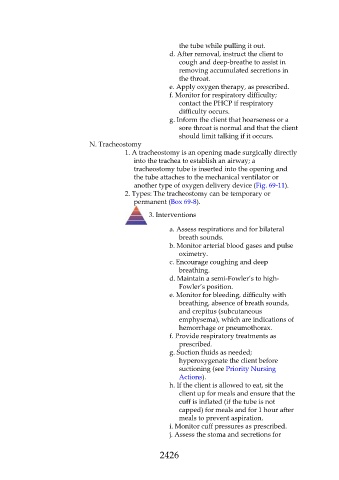Page 2426 - Saunders Comprehensive Review For NCLEX-RN
P. 2426
the tube while pulling it out.
d. After removal, instruct the client to
cough and deep-breathe to assist in
removing accumulated secretions in
the throat.
e. Apply oxygen therapy, as prescribed.
f. Monitor for respiratory difficulty;
contact the PHCP if respiratory
difficulty occurs.
g. Inform the client that hoarseness or a
sore throat is normal and that the client
should limit talking if it occurs.
N. Tracheostomy
1. A tracheostomy is an opening made surgically directly
into the trachea to establish an airway; a
tracheostomy tube is inserted into the opening and
the tube attaches to the mechanical ventilator or
another type of oxygen delivery device (Fig. 69-11).
2. Types: The tracheostomy can be temporary or
permanent (Box 69-8).
3. Interventions
a. Assess respirations and for bilateral
breath sounds.
b. Monitor arterial blood gases and pulse
oximetry.
c. Encourage coughing and deep
breathing.
d. Maintain a semi-Fowler’s to high-
Fowler’s position.
e. Monitor for bleeding, difficulty with
breathing, absence of breath sounds,
and crepitus (subcutaneous
emphysema), which are indications of
hemorrhage or pneumothorax.
f. Provide respiratory treatments as
prescribed.
g. Suction fluids as needed;
hyperoxygenate the client before
suctioning (see Priority Nursing
Actions).
h. If the client is allowed to eat, sit the
client up for meals and ensure that the
cuff is inflated (if the tube is not
capped) for meals and for 1 hour after
meals to prevent aspiration.
i. Monitor cuff pressures as prescribed.
j. Assess the stoma and secretions for
2426

